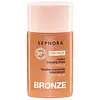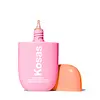What's inside
What's inside
 Key Ingredients
Key Ingredients

 Benefits
Benefits

 Concerns
Concerns

 Ingredients Side-by-side
Ingredients Side-by-side

Water
Skin ConditioningGlycerin
HumectantMica
Cosmetic ColorantCI 77891
Cosmetic ColorantCI 77491
Cosmetic ColorantPropanediol
SolventGlass Beads
AbrasiveHydroxypropyl Methylcellulose
Emulsion StabilisingPentaerythrityl Tetraisostearate
EmollientHydrogenated Starch Hydrolysate
HumectantSodium Polyacrylate Starch
AbsorbentHydroxyacetophenone
Antioxidant1,2-Hexanediol
Skin ConditioningCaprylyl Glycol
EmollientCI 77499
Cosmetic ColorantCaprylic/Capric Triglyceride
MaskingChlorphenesin
AntimicrobialPectin
Emulsion StabilisingXanthan Gum
EmulsifyingHelianthus Annuus Seed Oil
EmollientTin Oxide
AbrasiveChlorella Vulgaris Extract
Skin ConditioningRosmarinus Officinalis Leaf Extract
AntimicrobialWater, Glycerin, Mica, CI 77891, CI 77491, Propanediol, Glass Beads, Hydroxypropyl Methylcellulose, Pentaerythrityl Tetraisostearate, Hydrogenated Starch Hydrolysate, Sodium Polyacrylate Starch, Hydroxyacetophenone, 1,2-Hexanediol, Caprylyl Glycol, CI 77499, Caprylic/Capric Triglyceride, Chlorphenesin, Pectin, Xanthan Gum, Helianthus Annuus Seed Oil, Tin Oxide, Chlorella Vulgaris Extract, Rosmarinus Officinalis Leaf Extract
Zinc Oxide 21.7%
Cosmetic ColorantWater
Skin ConditioningC13-15 Alkane
SolventCaprylic/Capric Triglyceride
MaskingButyloctyl Salicylate
Skin ConditioningPropanediol
SolventMica
Cosmetic ColorantPolyglyceryl-2 Dipolyhydroxystearate
Skin ConditioningPolyglyceryl-3 Diisostearate
EmulsifyingSilica
AbrasiveC12-15 Alkyl Benzoate
AntimicrobialPolyglyceryl-3 Polyricinoleate
EmulsifyingGalactoarabinan
Allantoin
Skin ConditioningFructooligosaccharides
HumectantBioflavonoids
Skin ConditioningGlycoproteins
Skin ConditioningBisabolol
MaskingCeramide Ng
Skin ConditioningLactic Acid
BufferingSodium Hyaluronate
HumectantPalmitoyl Hexapeptide-12
Skin ConditioningCyamopsis Tetragonoloba Gum
Emulsion StabilisingTocopheryl Acetate
AntioxidantDisteardimonium Hectorite
StabilisingGlycerin
HumectantPolyhydroxystearic Acid
EmulsifyingTribehenin
EmollientIsostearic Acid
CleansingLecithin
EmollientXanthan Gum
EmulsifyingSodium Chloride
MaskingPhytic Acid
Pentylene Glycol
Skin ConditioningPhenethyl Alcohol
MaskingCI 77891
Cosmetic ColorantCI 77491
Cosmetic ColorantCI 77492
Cosmetic ColorantZinc Oxide 21.7%, Water, C13-15 Alkane, Caprylic/Capric Triglyceride, Butyloctyl Salicylate, Propanediol, Mica, Polyglyceryl-2 Dipolyhydroxystearate, Polyglyceryl-3 Diisostearate, Silica, C12-15 Alkyl Benzoate, Polyglyceryl-3 Polyricinoleate, Galactoarabinan, Allantoin, Fructooligosaccharides, Bioflavonoids, Glycoproteins, Bisabolol, Ceramide Ng, Lactic Acid, Sodium Hyaluronate, Palmitoyl Hexapeptide-12, Cyamopsis Tetragonoloba Gum, Tocopheryl Acetate, Disteardimonium Hectorite, Glycerin, Polyhydroxystearic Acid, Tribehenin, Isostearic Acid, Lecithin, Xanthan Gum, Sodium Chloride, Phytic Acid, Pentylene Glycol, Phenethyl Alcohol, CI 77891, CI 77491, CI 77492
 Reviews
Reviews

Ingredients Explained
These ingredients are found in both products.
Ingredients higher up in an ingredient list are typically present in a larger amount.
This ingredient is an emollient, solvent, and texture enhancer. It is considered a skin-softener by helping the skin prevent moisture loss.
It helps thicken a product's formula and makes it easier to spread by dissolving clumping compounds.
Caprylic Triglyceride is made by combining glycerin with coconut oil, forming a clear liquid.
While there is an assumption Caprylic Triglyceride can clog pores due to it being derived from coconut oil, there is no research supporting this.
Learn more about Caprylic/Capric TriglycerideCi 77491 is also hydrated iron III oxide. It's sole purpose is to give a red/pink hue to products.
Iron III oxides are classified as inorganic chemicals for coloring.
Synthetically created Ci 77491 is considered safer than those naturally found. This is because the synthetically created version may contain less impurities. Iron oxides are generally non-toxic and non-allergenic.
Learn more about CI 77491Ci 77891 is a white pigment from Titanium dioxide. It is naturally found in minerals such as rutile and ilmenite.
It's main function is to add a white color to cosmetics. It can also be mixed with other colors to create different shades.
Ci 77891 is commonly found in sunscreens due to its ability to block UV rays.
Learn more about CI 77891Glycerin is already naturally found in your skin. It helps moisturize and protect your skin.
A study from 2016 found glycerin to be more effective as a humectant than AHAs and hyaluronic acid.
As a humectant, it helps the skin stay hydrated by pulling moisture to your skin. The low molecular weight of glycerin allows it to pull moisture into the deeper layers of your skin.
Hydrated skin improves your skin barrier; Your skin barrier helps protect against irritants and bacteria.
Glycerin has also been found to have antimicrobial and antiviral properties. Due to these properties, glycerin is often used in wound and burn treatments.
In cosmetics, glycerin is usually derived from plants such as soybean or palm. However, it can also be sourced from animals, such as tallow or animal fat.
This ingredient is organic, colorless, odorless, and non-toxic.
Glycerin is the name for this ingredient in American English. British English uses Glycerol/Glycerine.
Learn more about GlycerinMica is a naturally occurring mineral used to add shimmer and color in cosmetics. It can also help improve the texture of a product or give it an opaque, white/silver color.
Serecite is the name for very fine but ragged grains of mica.
This ingredient is often coated with metal oxides like titanium dioxide. Trace amounts of heavy metals may be found in mica, but these metals are not harmful in our personal products.
Mica has been used since prehistoric times throughout the world. Ancient Egyptian, Indian, Greek, Roman, Aztec, and Chinese civilizations have used mica.
Learn more about MicaPropanediol is an all-star ingredient. It softens, hydrates, and smooths the skin.
It’s often used to:
Propanediol is not likely to cause sensitivity and considered safe to use. It is derived from corn or petroleum with a clear color and no scent.
Learn more about PropanediolWater. It's the most common cosmetic ingredient of all. You'll usually see it at the top of ingredient lists, meaning that it makes up the largest part of the product.
So why is it so popular? Water most often acts as a solvent - this means that it helps dissolve other ingredients into the formulation.
You'll also recognize water as that liquid we all need to stay alive. If you see this, drink a glass of water. Stay hydrated!
Learn more about WaterXanthan gum is used as a stabilizer and thickener within cosmetic products. It helps give products a sticky, thick feeling - preventing them from being too runny.
On the technical side of things, xanthan gum is a polysaccharide - a combination consisting of multiple sugar molecules bonded together.
Xanthan gum is a pretty common and great ingredient. It is a natural, non-toxic, non-irritating ingredient that is also commonly used in food products.
Learn more about Xanthan Gum